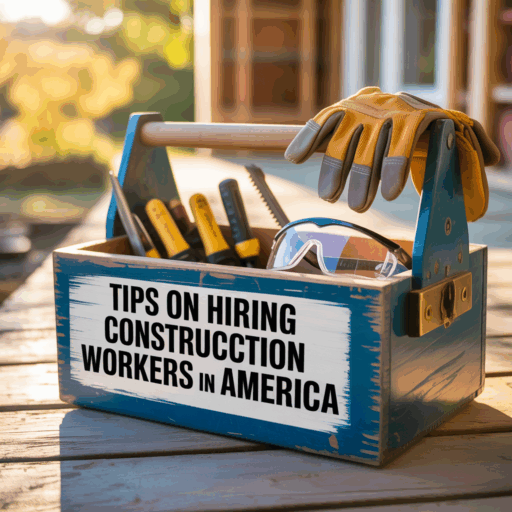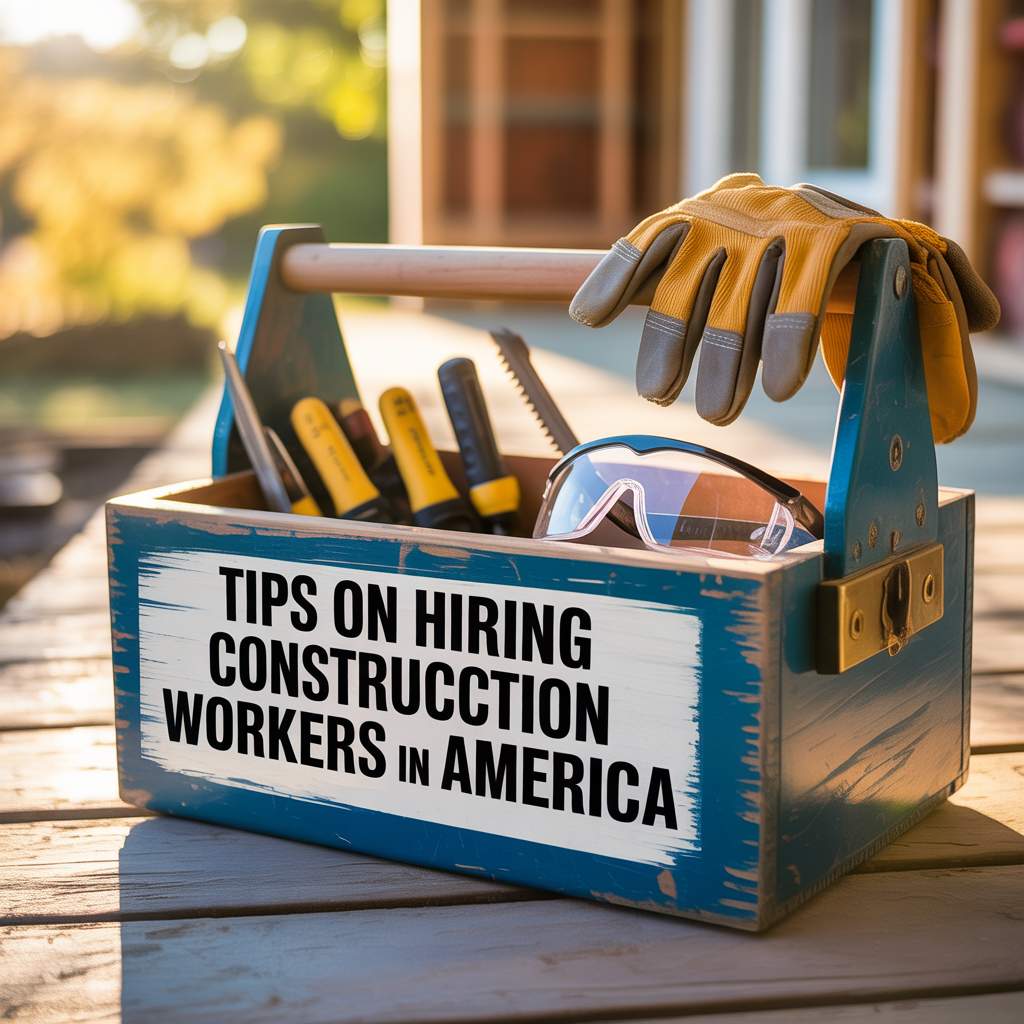America is building more than ever before. Roads, homes, hospitals, and commercial towers are rising across the country. But there’s one problem: not enough skilled hands to do the work.
According to the latest data from the U.S. Bureau of Labor Statistics (BLS), over 430,000 construction jobs were left unfilled in early 2025. That’s a sharp warning for contractors, developers, and builders: demand is growing, but the supply of skilled labor is shrinking. This isn’t a short-term problem, it’s a trend that has been building for years.
Here’s what’s causing the gap:
- Many older workers are retiring or leaving the industry.
- Fewer young people are entering construction trades.
- Some have moved into tech or remote jobs.
- Immigration rules are stricter, limiting foreign labor.
- The housing boom and infrastructure push have raised demand.
For construction firms in America, this creates a tough reality. Without the right workers, projects get delayed, budgets stretch, safety risks rise, and reputations suffer. That’s why smart recruitment is critical in 2025. In the construction world, your workers are everything. A strong team builds strong structures. A weak one leads to mistakes, rework, and missed deadlines.
This guide is designed for builders, contractors, and construction business owners. You’ll find actionable solutions to real hiring challenges:
11 Tips for Hiring Construction Workers
Hiring skilled construction workers in the U.S. is tougher than ever due to a growing labor shortage and rising demand. These 11 tips will help you attract, hire, and keep the right people for your construction projects in 2025.
Set Clear Recruitment Goals & Workforce Needs
Before recruiting anyone, step back and get clear about what you truly need. Many construction businesses in the U.S. skip this part and end up with the wrong worker or not enough of the right ones. Planning is your best tool.
Start with job types. What roles are you hiring for?
- Full-time workers: These are your long-term foundation. You’ll invest in them, train them, and expect them to grow with your company.
- Subcontractors: These are specialized workers or individuals you bring in for specific scopes.
- Temporary or seasonal workers: For peak seasons, rush jobs, or short-term projects, these workers help you stay on schedule.
Next, identify the skill sets you need:
- General laborers: Can handle physical tasks, loading, site cleanup, and basic assistance.
- Skilled trades (MEP): This includes Heavy Equipment Operator, Civil Engineer, and Site Supervisor/Foreman. These are often licensed roles with higher pay.
- Supervisors and foremen: These leaders must know the field, manage teams, read blueprints, and keep projects moving.
Think of this as inventory planning for people. Just like materials and tools, labor needs to be forecasted accurately.
Then, map out your timeline:
- Are you hiring for seasonal rushes, like summer concrete or winter interiors?
- Or do you need year-round support for long-term commercial builds?
Build a Strong Employer Brand in Construction
Workers choose companies just like companies choose workers. This means you need to be different, not just for what you build, but for how you treat your team.
Your employer brand is what people think about working for you. It helps you attract good workers even before you advertise a job.
Start with your core values. What do you stand for?
- Are you known for a safe work environment?
- Do you pay on time and treat people with respect?
- Are you committed to career growth and stability?
Then, show it off. Don’t just say you’re a great place to work—prove it:
- Post pictures and videos from your sites. Let people see the kind of projects you build.
- Share employee stories, how a helper became a foreman, or how a worker bought his first home after a steady year on your team.
- Ask for testimonials from current crew members. Nothing builds trust like real voices.
Workers today care about more than just wages. They’re looking for:
- Stability in a volatile market
- Benefits like health care or paid time off
- A workplace culture where they feel respected
- Technology that makes their job easier, like Sage 300 CRE for seamless job costing, payroll, and project management
If you offer these things, don’t keep them a secret. Put it on your website, share it on social media, and also talk about it during interviews.
Write Compelling and Precise Job Descriptions
A Construction job description is more than a list of duties, it’s the first handshake between your company and potential hires. In today’s digital US job market, a vague or generic posting simply gets lost. To compete for talent, especially when labor is scarce, your listings need to speak directly to the people you want to hire.
Start with clarity. Use job titles that construction workers search for, not internal terms that only your team understands. Listing a pay range builds trust and helps filter serious applicants. Be clear about what certifications or licenses are required, such as OSHA 30 card, CDL, or specific trade licenses.
Don’t just focus on hard skills like blueprint reading or tool handling, mention soft skills too, like teamwork, punctuality, or leadership potential.
Beyond the basics, show them the upside. Talk about growth opportunities: Can a laborer move into a lead role? Will seasoned masons eventually supervise construction workers? Share what makes working with you unique.
This could be access to top-tier equipment, consistent hours, jobsite safety, or paid training. A good job post should not just describe the work, it should sell the experience of being part of your team.
Use the Right Channels to Post Jobs
Once your job description is strong, ensure it reaches the right audience in America. Many construction companies fail by posting in the wrong places or relying only on word of mouth. Today’s recruitment market is digital, so using the right channels is crucial.
Industry-specific sites like ConstructionJobs.com and iHireConstruction attract skilled workers and let you filter by trade, location, and experience.
Don’t overlook major job boards like Indeed, ZipRecruiter, and LinkedIn, which help your listings reach qualified candidates. LinkedIn is especially effective for management or engineering roles.
The key is to meet workers where they are. A strong post in the right place will attract serious applicants.
Go Beyond Job Boards: Creative Sourcing Ideas
Not every great worker is sitting on job sites waiting to be found. Some are still in training, some are exploring their next move, and others are open to offers but not actively searching. To reach them, you need to look beyond traditional job boards.
Start by building relationships with trade schools and technical colleges. These places are full of eager students who are trained, certified, and ready to work. Partnering with them gives you early access to fresh talent, whether it’s electricians, welders, HVAC techs, or heavy equipment operators.
Local job fairs and trade expos are also goldmines. You meet candidates face-to-face, showcase your projects, and build trust instantly. It’s also a chance to stand out, especially if you’re offering apprenticeships, training, or solid career paths.
Don’t forget local unions and veteran organizations. Union halls often have skilled workers looking for steady work. Military transition programs help you find disciplined workers who work well in teams. They are a great fit for construction jobs that need these skills.
Leverage Digital Tools & Social Media
Digital tools are changing how companies hire, and construction is no exception. If you’re still relying only on word of mouth or paper flyers, you’re missing the bigger picture.
Social media is a powerful tool. With Facebook and Instagram ads, you can target specific trades and zip codes, like framing crews in Dallas or drywallers in Phoenix. You can also post real job site content to show what it’s like to work with your team, real workers, real projects, and real results.
Recruitment software also helps. Using a CRM (Candidate Relationship Management tool) or an ATS (Applicant Tracking System) keeps all your resumes in one place, tracks who applied, and makes it easy to follow up. It saves time, keeps things organized, and makes you look more professional to job seekers.
Employee Referrals Still Work
When it comes to hiring solid people, your current team often knows best. Employee referrals are still one of the most effective ways to bring in reliable workers.
Give your crew a reason to refer. Offer a cash bonus when their referral gets hired and stays for a set time, like 30 or 60 days. Even a few hundred dollars can go a long way.
But don’t stop there. Publicly thank employees who help you find new hires. A shoutout at a morning meeting or a mention on the company page goes a long way. It shows you value their input and builds a team-first culture.
Over time, this creates a referral mindset. Your workers become your best recruiters, and you get workers who already know your standards and fit your job sites.
Train, Onboard, and Invest in Retention
Finding good workers is only half the job; keeping them is what builds strong crews. That starts with a solid onboarding process. When new hires show up, don’t just hand them a hard hat and point to the job site. Give them a proper orientation. Walk them through safety protocols, introduce the team, explain the chain of command, and assign a mentor if possible. A clear start builds confidence and reduces early dropouts.
But onboarding is just the beginning. If you want to hold onto good workers, show them a future. Create a development path. Maybe someone starts as a general laborer, then gets trained in a trade, then moves up to a lead or foreman role. When workers see growth, they stay longer.
Also, don’t wait for exit interviews to find out what’s wrong. Use “stay interviews” instead — short check-ins every few months. Ask what’s going well and what needs fixing. It shows you care and helps you catch small issues before they turn into lost workers.
Tackle Challenges in Remote & Seasonal Recruiting

Hiring for remote areas or seasonal peaks brings its own set of problems, but it’s possible to plan around them. If your project is far from big cities or trade hubs, consider offering relocation bonuses or travel stipends. It’s an upfront cost, but it gets the right talent on site when and where you need them.
Start forecasting your workforce early, months ahead of busy seasons. This gives you time to source labor before the rush and avoid last-minute scrambles.
Also, think modular when it comes to staffing. Not every job requires full-time employees. Use a mix of temps, subcontractors, and independent construction workers. This flexibility helps you scale up or down without long-term overhead, especially in climates or regions where work slows in winter or spikes in summer.
Union vs. Non-Union Hiring Considerations
Every construction market has its own rules, and that includes labor structure. Some projects, especially government or large commercial jobs, may require union labor, and others may not. Either way, you need to know the local regulations and contract terms before you start hiring.
If you’re working with unions, build good relationships with local halls and training centers. They can supply certified, trained workers quickly, but they expect clear communication and steady work in return. Respect goes both ways.
In non-union settings, you may have more flexibility on pay, hours, and crew structure — but you’ll need to take full responsibility for training, safety, and compliance. Either way, understanding how each system works helps you avoid delays and keeps your hiring smooth and legal.
Legal, Safety & Compliance Best Practices
In construction, legal and safety rules aren’t optional — they’re the foundation of a strong hiring process. Start with OSHA compliance. Make sure your job site follows all safety standards and that your workers are trained to avoid injuries. For instance for home construction, don’t let bad plumbing work affect your home. Take care of your property with quality Backflow Repair Services at San Diego Backflow Testing.
Next, stay on the right side of labor laws. Use E-Verify to confirm work eligibility, and if needed, run drug tests and background checks — especially for roles involving heavy equipment or security clearance.
Most importantly, be careful with how you classify your workers. If someone works like an employee — regular hours, using your tools, under your supervision — don’t label them as an independent contractor. Misclassification can lead to fines and legal issues. Get it right from day one.
What Challenges Can Be Faced in Hiring Construction Workers in America
Hiring construction workers in the U.S. today is not as easy as posting a job and waiting for applicants. The industry is facing some serious and ongoing challenges that every contractor, builder, or construction firm needs to understand.
- Skilled Labor Shortage: There’s a significant lack of skilled workers, with many construction job openings unfilled. Experienced workers are retiring, and fewer young people are entering the trades.
- Aging Workforce: A large portion of the construction workforce is over 50 years old. As these workers retire, their valuable knowledge and experience leave a critical gap.
- Rising Competition for Talent: With many ongoing projects, companies are vying for a limited pool of workers. This competition drives up wages, making it difficult for smaller firms to hire experienced staff.
- Fluctuating Workloads: Construction work is often inconsistent, slowing during winter or due to delays. This makes it challenging to maintain a full team year-round, leading to late hiring.
- Geographic Challenges: Some projects are located in remote areas with insufficient local labor. Recruiting workers to relocate for short-term jobs requires strong incentives like housing support.
- Language Barriers: Many construction workers speak languages other than English, creating communication issues. This can make it hard to understand safety instructions and legal documents on-site.
- Regulatory Complexity: Labor laws vary by state, including union rules and OSHA standards. Navigating these regulations is time-consuming, and errors can lead to penalties or project delays.
- Negative Perception of Construction Jobs: Younger generations often view construction as low-status, physically demanding work. Without effective outreach, many opt for tech or office jobs despite better pay in trades.
FAQs
1. Why is it so hard to hire construction workers in the U.S.?
There’s a major shortage of skilled workers due to retirements and fewer young people entering the trades. Demand for construction is rising, but labor supply is not keeping up. This gap makes hiring very competitive.
2. What type of workers should construction companies hire?
It depends on the project. You may need full-time employees, subcontractors, or temp workers. Planning workforce types helps reduce delays and manage costs.
3. How can companies attract better construction talent?
Offer fair pay, clear growth paths, and a safe work culture. Use job boards, social media, and referrals to spread the word. Make your company look stable, professional, and people-friendly.
4. What legal steps must be followed when hiring in construction?
Follow OSHA safety laws, use E-Verify, and run background checks. Make sure workers are properly classified, contractor vs. employee. Skipping these steps can lead to fines or shutdowns.
5. How do you hire for remote or seasonal construction work?
Plan before peak seasons and offer travel or relocation support. Use temp agencies, subs, or modular labor models. Being flexible helps you staff up when and where it’s needed most.


